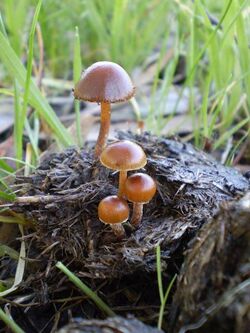Biology:Deconica coprophila
| Deconica coprophila | |
|---|---|

| |
| Scientific classification | |
| Domain: | Eukaryota |
| Kingdom: | Fungi |
| Division: | Basidiomycota |
| Class: | Agaricomycetes |
| Order: | Agaricales |
| Family: | Strophariaceae |
| Genus: | Deconica |
| Species: | D. coprophila
|
| Binomial name | |
| Deconica coprophila (Bull.) P.Karst (1821)
| |
| Synonyms[1] | |
|
Agaricus coprophilus Bull. (1793) | |
Deconica coprophila, commonly known as the dung-loving psilocybe, meadow muffin mushroom,[2] or dung demon, is a species of mushroom in the family Strophariaceae. First described as Agaricus coprophilus by Jean Baptiste François Pierre Bulliard in 1793,[3] it was transferred to the genus Psilocybe by Paul Kummer in 1871.[4] In the first decade of the 2000s, several molecular studies showed that the Psilocybe was polyphyletic,[5][6][7] and the non-bluing (non-hallucinogenic) species were transferred to Deconica.[8]
It can grow on cattle dung.[9]
While non-toxic, the species is not a good edible mushroom.[10]
References
| Deconia coprophilia | |
|---|---|
| Mycological characteristics | |
| gills on hymenium | |
| cap is convex | |
| hymenium is adnate or decurrent | |
| stipe is bare | |
| spore print is purple-brown | |
| ecology is saprotrophic | |
| edibility: unknown | |
- ↑ "Psilocybe coprophila (Bull.) P. Kumm. 1871". MycoBank. International Mycological Association. http://www.mycobank.org/MycoTaxo.aspx?Link=T&Rec=355554.
- ↑ Arora, David (1986). Mushrooms demystified: a comprehensive guide to the fleshy fungi (Second ed.). Berkeley: Ten Speed Press. ISBN 978-0-89815-169-5.
- ↑ Bulliard JBF. (1793) (in French). Histoire des champignons de la France. 2. p. 243.
- ↑ Kummer P. (1871) (in German). Der Führer in die Pilzkunde (1 ed.). p. 71.
- ↑ "One hundred and seventeen clades of euagarics". Molecular Phylogenetics and Evolution 23 (3): 357–400. 2002. doi:10.1016/S1055-7903(02)00027-1. PMID 12099793.
- ↑ "Forensic analysis of hallucinogenic fungi: a DNA-based approach". Forensic Science International 140 (2–3): 147–57. 2004. doi:10.1016/j.forsciint.2003.11.022. PMID 15036436.
- ↑ "Major clades of Agaricales: a multilocus phylogenetic overview". Mycologia 98 (6): 982–95. 2006. doi:10.3852/mycologia.98.6.982. PMID 17486974. http://www.mycologia.org/content/98/6/982.full.pdf.
- ↑ Norvell L. (2009). "Report of the Nomenclature Committee for Fungi: 15". Mycotaxon 110: 487–92. doi:10.5248/110.487. http://www.ima-mycology.org/CFF/pdf/Fungi-15.pdf.
- ↑ Pauline, N'Douba Amako; Claude, Kouassi Kouadio; Clovis, Koffi N'Dono Boni; Allal, Douira; Koutoua, Ayolié (2022). "Coprophilous fungi of Daloa city: New species for the fungal flora of Côte d'Ivoire". GSC Biological and Pharmaceutical Sciences 20 (3): 251-260. doi:10.30574/gscbps.2022.20.3.0362.
- ↑ Miller Jr., Orson K.; Miller, Hope H. (2006). North American Mushrooms: A Field Guide to Edible and Inedible Fungi. Guilford, CN: FalconGuide. pp. 250. ISBN 978-0-7627-3109-1.
External links
Wikidata ☰ {{{from}}} entry
 |

